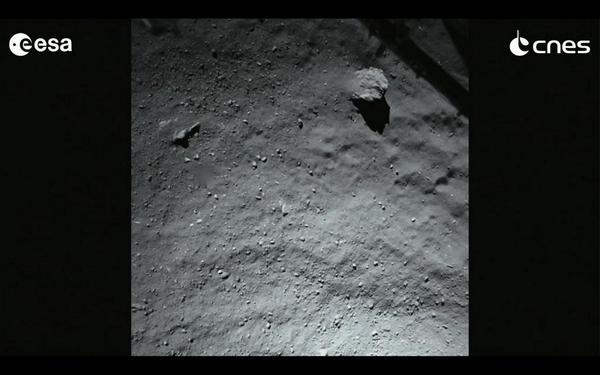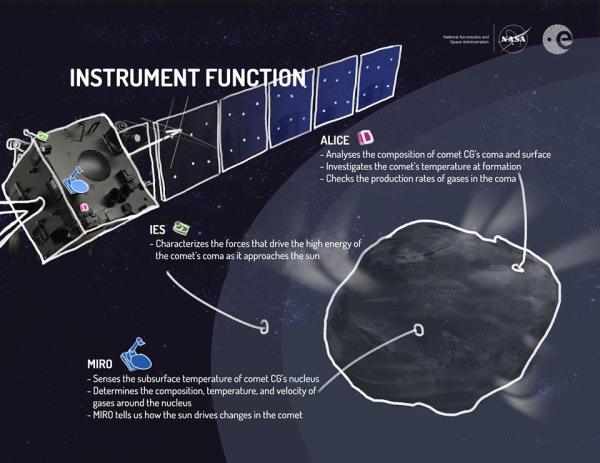“I must trust that the little bit of love that I sow now will bear many fruits, here in this world and the life to come.” -Henri Nouwen
So, maybe you've been living under a rock, but whether you have or haven't, the news is still amazing: we've just landed on our first not-a-rock in space, but rather the remnants of an icy world from our Solar System's early moments of formation.
 Image credit: ESA / CNES / Philae, via https://twitter.com/ObservingSpace/status/532596055783661568/photo/1.
Image credit: ESA / CNES / Philae, via https://twitter.com/ObservingSpace/status/532596055783661568/photo/1.
That's right, for the first time ever, we've landed a manmade probe on a comet, and are now prepared to do some amazing science that would have been unfathomable just a short few years ago.


The wish that came to fruition through good science, and action.
What are the prospects of the mission if the harpoons didn't engage as suspected?
@critter42 #2: The failed thruster and harpoons were meant to be "initial grab" devices, to keep the lander in place before the ice screws could provide permanent holds. Apparently the landing screws did engage, or Philae wouldn't have reported back a "contact" signal. If that is correct, then the lander is stable and can do science.
We should know more tomorrow (U.S. time). There are several practical barriers: Rosetta's orbit has it out of radio contact with Philae until (I think) about 1 am EST, so there's no new telemetry data. The Philae/Rosetta uplink is relatively low bandwidth, so it takes a while to collect and process the raw data.
Unfortunately, real space science is much slower than we've all been led to believe by 60+ years of good SF movies. The real Mars rovers move at speeds of centimeters per second -- about as fast as a finger swiping across an iPhone, and nowhere near as fast as an RC car. It could take at least a day before ESA knows what state Philae is in.
latest update from today's press conf. ... philae bounced 2 times. first bounce was quite long, lasting more than hour of free glide, and a shorter one of couple of minutes. The lander is now estimated to around 800m-1km from the original site, but in an area very close to another chosen site.
Bad news is that the lander is not anchored, it's being held only by it's weight at the moment, and also that it's scewed since it stoped at what seems to be a bottom of the ridge. (there are some movement manouvers planed to try to better orient it). Second bad thing is that the solar coverage is only some 1.5h instead of 6-7h that was planned for in the first landing site, so this has impact on power consumption and re-charge times.
So good news, it has landed, is in tact, and transmitting. And some of the experiments are in full swing. Bad news.. not anchored, not standing on all 3 legs, and in partial shadow.
@Sinisa #4: Thanks for posting the update. In some ways, much worse than it seems from the initial data yesterday :-(, and much worse than I inferred in my optimistic posting last night.
I don't think the designers planned for an "air bag" landing, but the extremely low relative speed reduced the potential for damage. Hopefully they can get some data out in the next two days before the batteries run down.
Latest update from CNN coverage is that Philae's battery is expected to last until Saturday or Sunday (because of less sunlight hours). The research team is going to take the standard strategy of not messing with the position, collecting all the low-risk data they can for as long as they can. They will only try high-risk strategies like moving it or jostling it into a better position after they have collected a lot of data and the batteries are almost dead.
@ Michael
Sadly it was bad luck, or two connected errors.. however we look at it. first problem was the failure of cold jet nitrogen booster (actually the failure of pins to punch the seal to let gas in) which should have "stuck it" to the ground, and then the failure of anchor to attach. The screws in legs would only work if the lander was actually still.
As for data, I think they said that the first results of CONCERT I think is the experiment (the radar imaging of interior), will be available probably by tomorrow morning if not sooner.
Am no expert really, but my guess is that experiments that measure magnetics, radar, temperature and ofc photos are all fine and don't really depend how philea landed. The digging part and sample collection I don't know how and if can cope with this. hopefully someone anticipated a scenario where it's not laying flat. The other issue that any action will cause a reaction since it's not anchored in any way. Nervous weeks ahead for sure :)
Michael @3. There was an episode on The Big Bang Theory featuring a Mars Rover. Howard was to throw the first ball for a baseball game, but his throwing was so awful he decided to deliver the ball to the plate by Mars Rover. Of course he was seen as a real smuck once the audience realized how long it was going to take to drive sixty feet!